Human Factors in Aviation: Engineering, Design, and Technology
VerifiedAdded on 2022/08/20
|6
|786
|25
Homework Assignment
AI Summary
This assignment delves into the critical role of human factors in aviation, addressing engineering and design challenges, and the application of systems, design, humanistic, and scientific thinking to improve human performance and aviation safety. It examines the impact of automation on human performance, highlighting the shift from physical mockups to digital human models. Furthermore, the assignment identifies and discusses the integration of new technologies in design efficiency and human performance across the aviation industry, including the use of 3D posture libraries and digital mannequins for workstation evaluations. The assignment refers to the research paper 'Towards virtual ergonomics: aviation and aerospace' by J. Sanjog et al., emphasizing the importance of digital human modeling in the aviation and aerospace sectors.
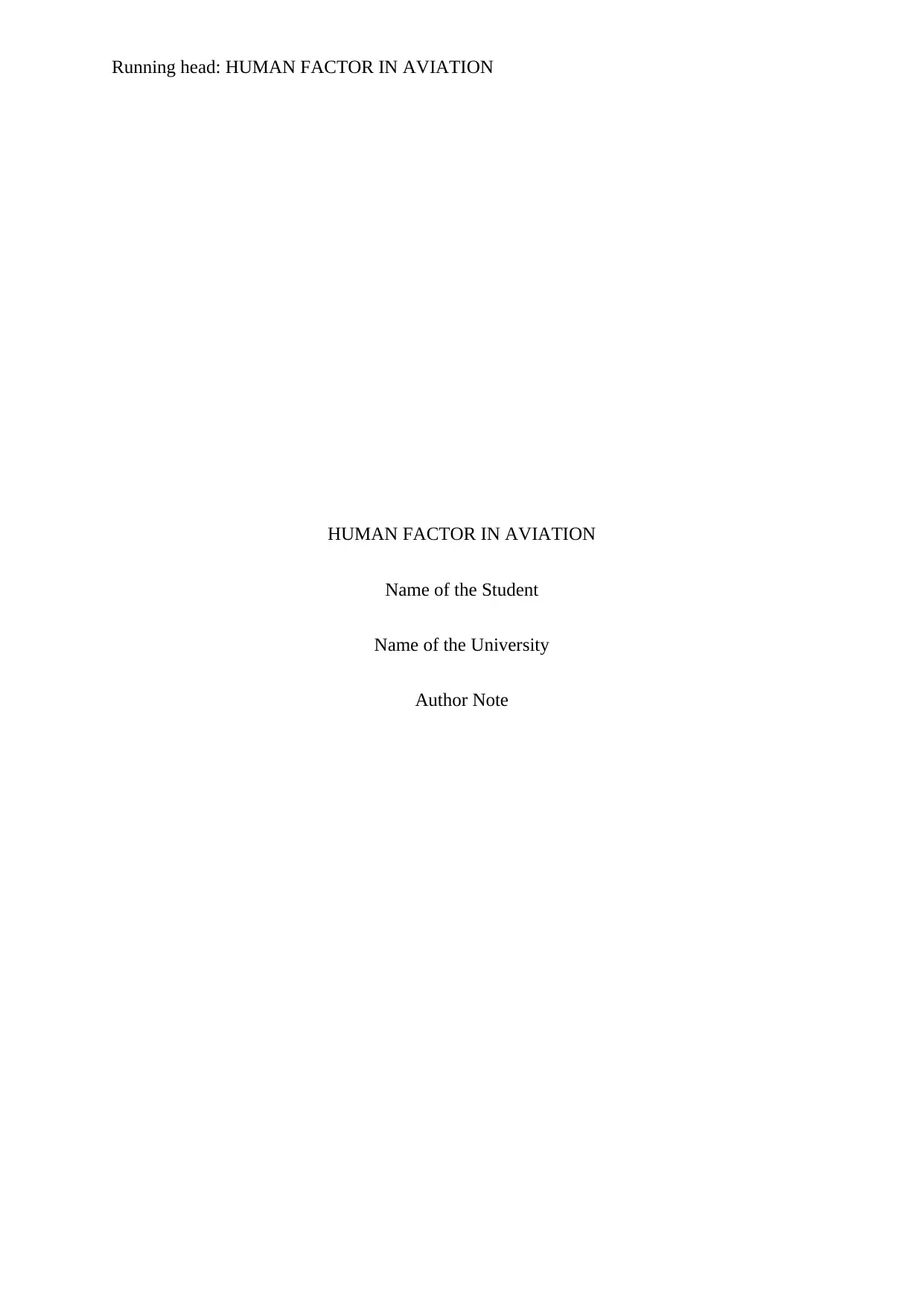
Running head: HUMAN FACTOR IN AVIATION
HUMAN FACTOR IN AVIATION
Name of the Student
Name of the University
Author Note
HUMAN FACTOR IN AVIATION
Name of the Student
Name of the University
Author Note
Paraphrase This Document
Need a fresh take? Get an instant paraphrase of this document with our AI Paraphraser
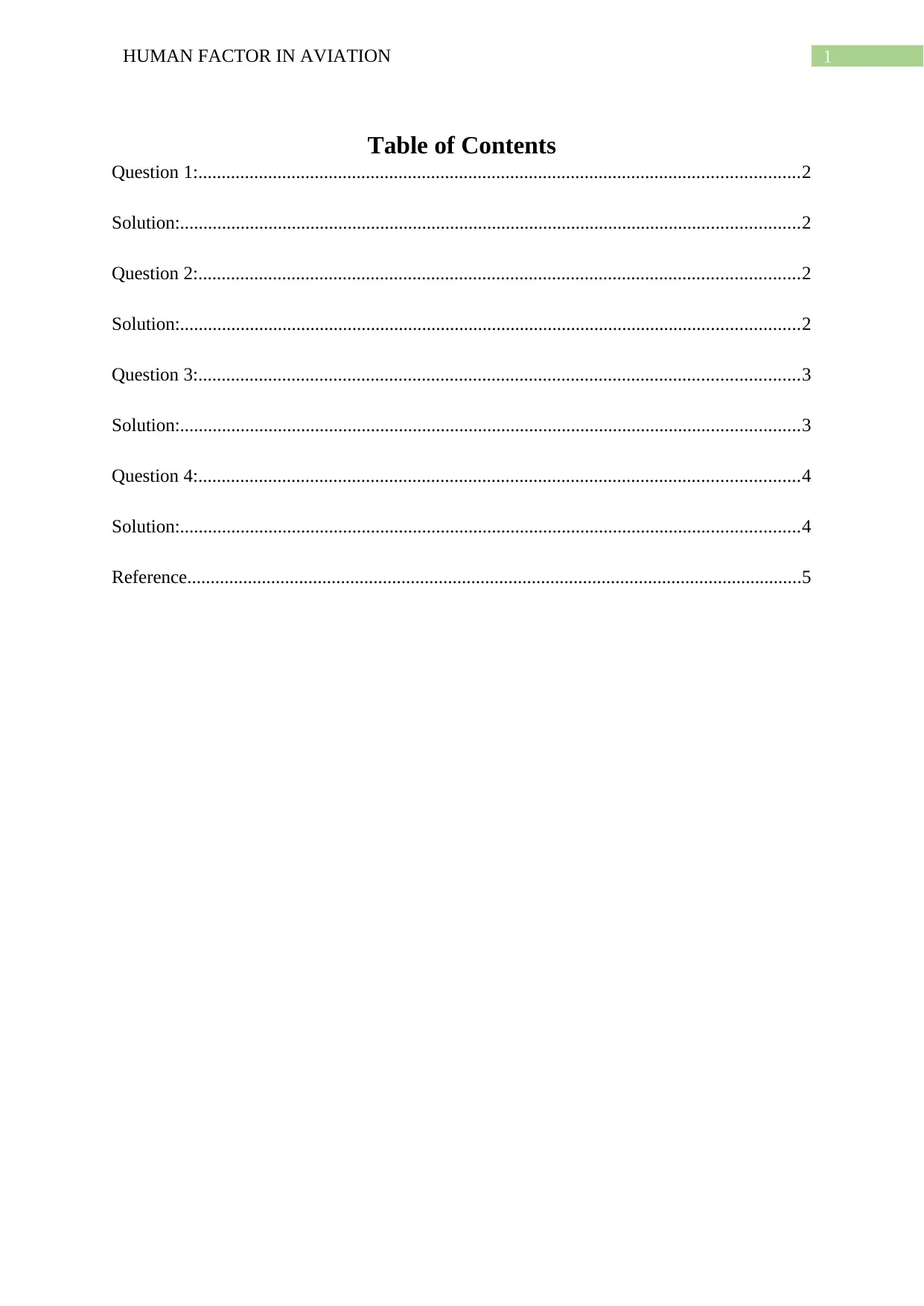
1HUMAN FACTOR IN AVIATION
Table of Contents
Question 1:.................................................................................................................................2
Solution:.....................................................................................................................................2
Question 2:.................................................................................................................................2
Solution:.....................................................................................................................................2
Question 3:.................................................................................................................................3
Solution:.....................................................................................................................................3
Question 4:.................................................................................................................................4
Solution:.....................................................................................................................................4
Reference....................................................................................................................................5
Table of Contents
Question 1:.................................................................................................................................2
Solution:.....................................................................................................................................2
Question 2:.................................................................................................................................2
Solution:.....................................................................................................................................2
Question 3:.................................................................................................................................3
Solution:.....................................................................................................................................3
Question 4:.................................................................................................................................4
Solution:.....................................................................................................................................4
Reference....................................................................................................................................5
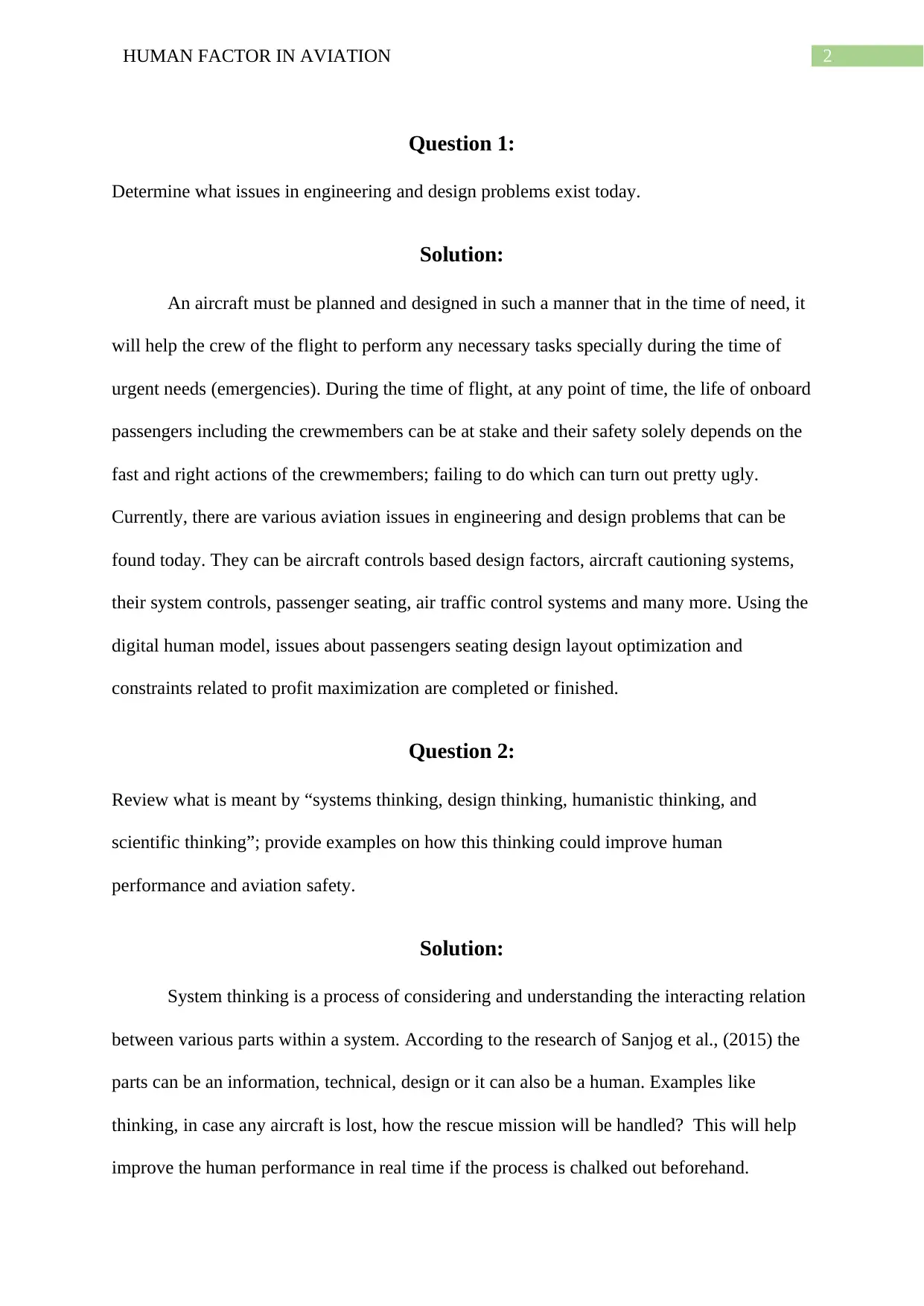
2HUMAN FACTOR IN AVIATION
Question 1:
Determine what issues in engineering and design problems exist today.
Solution:
An aircraft must be planned and designed in such a manner that in the time of need, it
will help the crew of the flight to perform any necessary tasks specially during the time of
urgent needs (emergencies). During the time of flight, at any point of time, the life of onboard
passengers including the crewmembers can be at stake and their safety solely depends on the
fast and right actions of the crewmembers; failing to do which can turn out pretty ugly.
Currently, there are various aviation issues in engineering and design problems that can be
found today. They can be aircraft controls based design factors, aircraft cautioning systems,
their system controls, passenger seating, air traffic control systems and many more. Using the
digital human model, issues about passengers seating design layout optimization and
constraints related to profit maximization are completed or finished.
Question 2:
Review what is meant by “systems thinking, design thinking, humanistic thinking, and
scientific thinking”; provide examples on how this thinking could improve human
performance and aviation safety.
Solution:
System thinking is a process of considering and understanding the interacting relation
between various parts within a system. According to the research of Sanjog et al., (2015) the
parts can be an information, technical, design or it can also be a human. Examples like
thinking, in case any aircraft is lost, how the rescue mission will be handled? This will help
improve the human performance in real time if the process is chalked out beforehand.
Question 1:
Determine what issues in engineering and design problems exist today.
Solution:
An aircraft must be planned and designed in such a manner that in the time of need, it
will help the crew of the flight to perform any necessary tasks specially during the time of
urgent needs (emergencies). During the time of flight, at any point of time, the life of onboard
passengers including the crewmembers can be at stake and their safety solely depends on the
fast and right actions of the crewmembers; failing to do which can turn out pretty ugly.
Currently, there are various aviation issues in engineering and design problems that can be
found today. They can be aircraft controls based design factors, aircraft cautioning systems,
their system controls, passenger seating, air traffic control systems and many more. Using the
digital human model, issues about passengers seating design layout optimization and
constraints related to profit maximization are completed or finished.
Question 2:
Review what is meant by “systems thinking, design thinking, humanistic thinking, and
scientific thinking”; provide examples on how this thinking could improve human
performance and aviation safety.
Solution:
System thinking is a process of considering and understanding the interacting relation
between various parts within a system. According to the research of Sanjog et al., (2015) the
parts can be an information, technical, design or it can also be a human. Examples like
thinking, in case any aircraft is lost, how the rescue mission will be handled? This will help
improve the human performance in real time if the process is chalked out beforehand.
⊘ This is a preview!⊘
Do you want full access?
Subscribe today to unlock all pages.

Trusted by 1+ million students worldwide
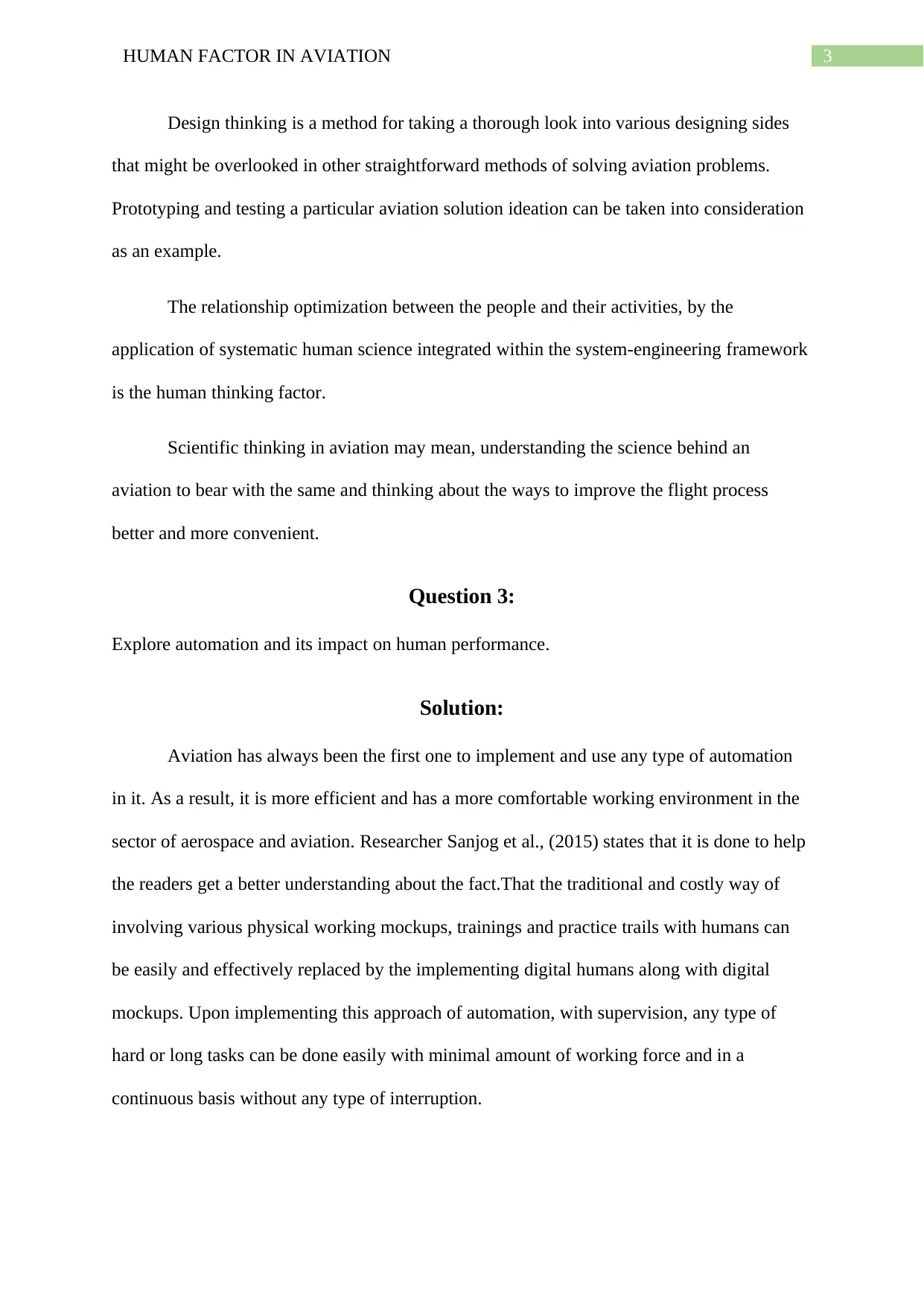
3HUMAN FACTOR IN AVIATION
Design thinking is a method for taking a thorough look into various designing sides
that might be overlooked in other straightforward methods of solving aviation problems.
Prototyping and testing a particular aviation solution ideation can be taken into consideration
as an example.
The relationship optimization between the people and their activities, by the
application of systematic human science integrated within the system-engineering framework
is the human thinking factor.
Scientific thinking in aviation may mean, understanding the science behind an
aviation to bear with the same and thinking about the ways to improve the flight process
better and more convenient.
Question 3:
Explore automation and its impact on human performance.
Solution:
Aviation has always been the first one to implement and use any type of automation
in it. As a result, it is more efficient and has a more comfortable working environment in the
sector of aerospace and aviation. Researcher Sanjog et al., (2015) states that it is done to help
the readers get a better understanding about the fact.That the traditional and costly way of
involving various physical working mockups, trainings and practice trails with humans can
be easily and effectively replaced by the implementing digital humans along with digital
mockups. Upon implementing this approach of automation, with supervision, any type of
hard or long tasks can be done easily with minimal amount of working force and in a
continuous basis without any type of interruption.
Design thinking is a method for taking a thorough look into various designing sides
that might be overlooked in other straightforward methods of solving aviation problems.
Prototyping and testing a particular aviation solution ideation can be taken into consideration
as an example.
The relationship optimization between the people and their activities, by the
application of systematic human science integrated within the system-engineering framework
is the human thinking factor.
Scientific thinking in aviation may mean, understanding the science behind an
aviation to bear with the same and thinking about the ways to improve the flight process
better and more convenient.
Question 3:
Explore automation and its impact on human performance.
Solution:
Aviation has always been the first one to implement and use any type of automation
in it. As a result, it is more efficient and has a more comfortable working environment in the
sector of aerospace and aviation. Researcher Sanjog et al., (2015) states that it is done to help
the readers get a better understanding about the fact.That the traditional and costly way of
involving various physical working mockups, trainings and practice trails with humans can
be easily and effectively replaced by the implementing digital humans along with digital
mockups. Upon implementing this approach of automation, with supervision, any type of
hard or long tasks can be done easily with minimal amount of working force and in a
continuous basis without any type of interruption.
Paraphrase This Document
Need a fresh take? Get an instant paraphrase of this document with our AI Paraphraser
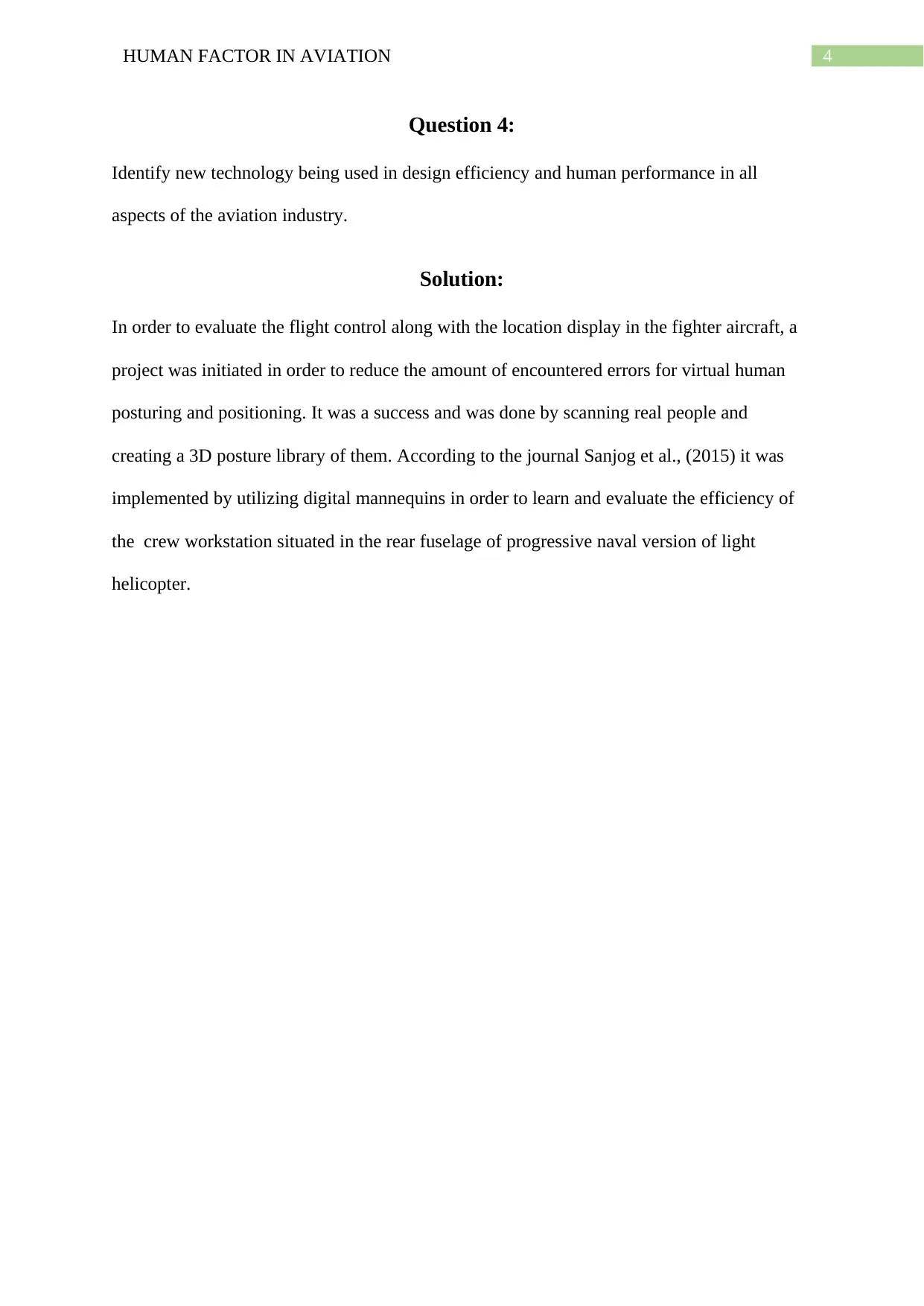
4HUMAN FACTOR IN AVIATION
Question 4:
Identify new technology being used in design efficiency and human performance in all
aspects of the aviation industry.
Solution:
In order to evaluate the flight control along with the location display in the fighter aircraft, a
project was initiated in order to reduce the amount of encountered errors for virtual human
posturing and positioning. It was a success and was done by scanning real people and
creating a 3D posture library of them. According to the journal Sanjog et al., (2015) it was
implemented by utilizing digital mannequins in order to learn and evaluate the efficiency of
the crew workstation situated in the rear fuselage of progressive naval version of light
helicopter.
Question 4:
Identify new technology being used in design efficiency and human performance in all
aspects of the aviation industry.
Solution:
In order to evaluate the flight control along with the location display in the fighter aircraft, a
project was initiated in order to reduce the amount of encountered errors for virtual human
posturing and positioning. It was a success and was done by scanning real people and
creating a 3D posture library of them. According to the journal Sanjog et al., (2015) it was
implemented by utilizing digital mannequins in order to learn and evaluate the efficiency of
the crew workstation situated in the rear fuselage of progressive naval version of light
helicopter.
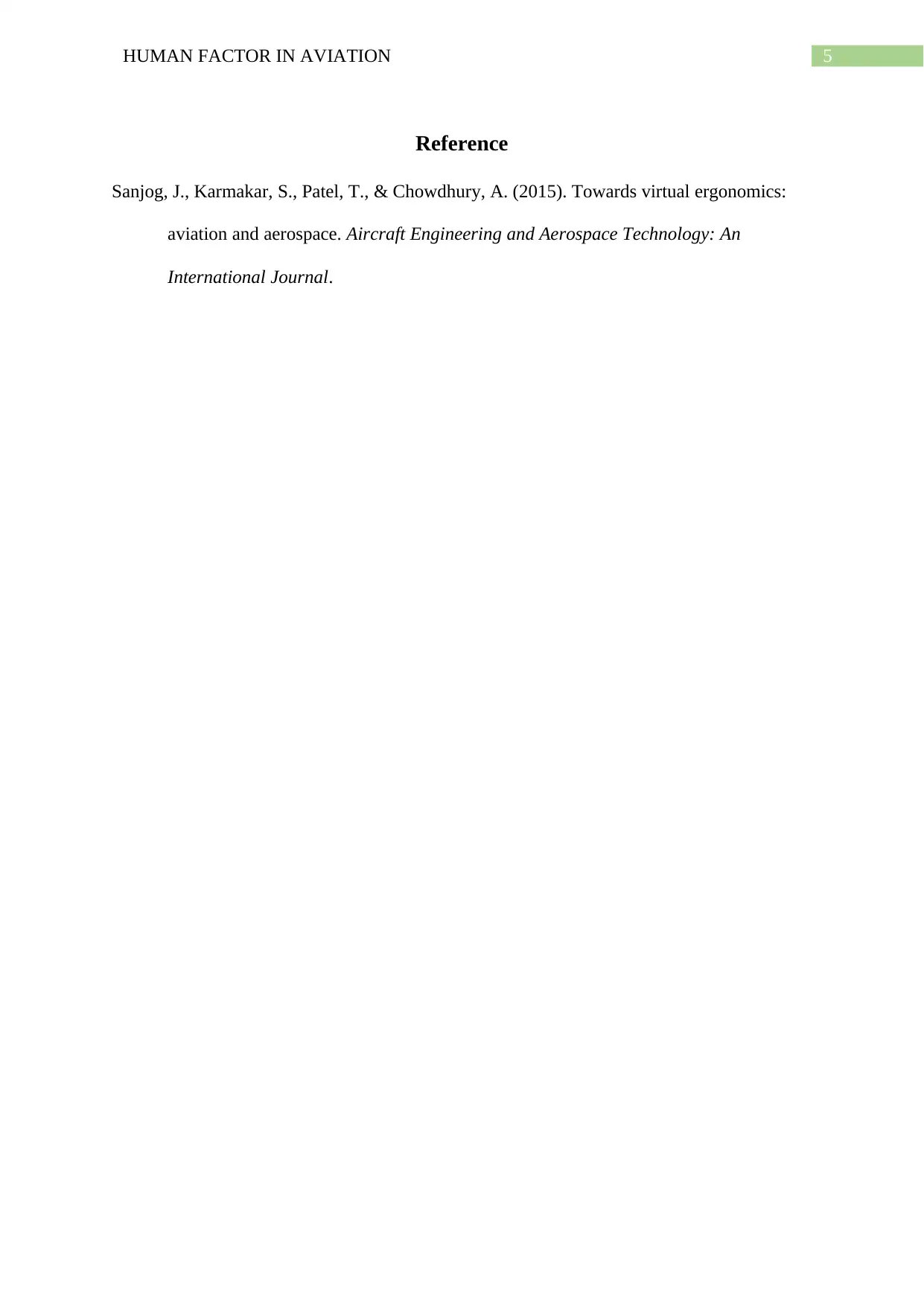
5HUMAN FACTOR IN AVIATION
Reference
Sanjog, J., Karmakar, S., Patel, T., & Chowdhury, A. (2015). Towards virtual ergonomics:
aviation and aerospace. Aircraft Engineering and Aerospace Technology: An
International Journal.
Reference
Sanjog, J., Karmakar, S., Patel, T., & Chowdhury, A. (2015). Towards virtual ergonomics:
aviation and aerospace. Aircraft Engineering and Aerospace Technology: An
International Journal.
⊘ This is a preview!⊘
Do you want full access?
Subscribe today to unlock all pages.

Trusted by 1+ million students worldwide
1 out of 6
Related Documents
Your All-in-One AI-Powered Toolkit for Academic Success.
+13062052269
info@desklib.com
Available 24*7 on WhatsApp / Email
![[object Object]](/_next/static/media/star-bottom.7253800d.svg)
Unlock your academic potential
Copyright © 2020–2025 A2Z Services. All Rights Reserved. Developed and managed by ZUCOL.




